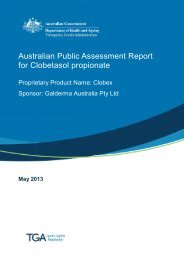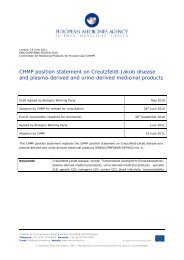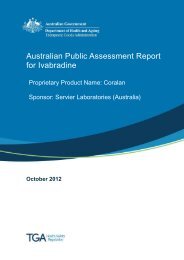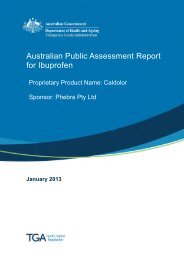AusPAR: Cabazitaxel - Therapeutic Goods Administration
AusPAR: Cabazitaxel - Therapeutic Goods Administration
AusPAR: Cabazitaxel - Therapeutic Goods Administration
You also want an ePaper? Increase the reach of your titles
YUMPU automatically turns print PDFs into web optimized ePapers that Google loves.
I. Introduction to Product Submission<br />
Submission Details<br />
Type of Submission: New Chemical Entity<br />
Decision: Approved<br />
Date of Decision: 5 December 2011<br />
Active ingredient(s): <strong>Cabazitaxel</strong> (as acetone solvate)<br />
<strong>AusPAR</strong> Jevtana <strong>Cabazitaxel</strong> Sanofi-Aventis Australia Pty Ltd PM-2010-02565-3-4<br />
Final 9 February 2012<br />
<strong>Therapeutic</strong> <strong>Goods</strong> <strong>Administration</strong><br />
Product Name(s): Jevtana, <strong>Cabazitaxel</strong> Winthrop, <strong>Cabazitaxel</strong> Sanofi<br />
Sponsor’s Name and Address: Sanofi-Aventis Australia Pty Ltd<br />
Dose form(s): Concentrated Injection<br />
Strength(s): 60 mg/1.5 mL<br />
Container(s): 1.5 mL vial with a 4.5 mL diluent vial<br />
Pack size(s): One pack contains the concentrate and diluent vial.<br />
Approved <strong>Therapeutic</strong> use: In combination with prednisone or prednisolone for the treatment<br />
of patients with hormone refractory metastatic prostate cancer<br />
previously treated with a docetaxel containing regimen.<br />
Route(s) of administration: Intravenous<br />
Dosage: 25 mg/m 2 1h infusion every 3 weeks with oral prednisone or<br />
prednisolone 10 mg daily throughout treatment<br />
ARTG Number (s): Awaiting ARTG inclusion<br />
Product Background<br />
<strong>Cabazitaxel</strong> is a semisynthetic compound derivative from 10-deacetylbaccatin III, which is<br />
extracted from European yew needles. This new taxane, which promotes the tubulin<br />
assembly in vitro and stabilises microtubules against cold induced depolymerisation as<br />
efficiently as docetaxel, was selected for development based on a better anti-proliferative<br />
activity on resistant cell lines than docetaxel. Using cell lines with acquired resistance to<br />
doxorubicin, vincristine, vinblastine, paclitaxel and docetaxel, the resistance factors<br />
ranged from 1.8 to 10 and 4.8 to 59, for cabazitaxel and for docetaxel, respectively.<br />
<strong>Cabazitaxel</strong> exhibited a broad spectrum of in vivo antitumour activity, not only in docetaxel<br />
sensitive tumour models, but also in tumour models in which docetaxel was poorly or not<br />
active. In addition, this compound was found to penetrate the blood brain barrier and<br />
marked antitumor activity was obtained in nude mice bearing intracranial glioblastomas.<br />
Prostate cancer is a major worldwide health problem. The initial treatment for metastatic<br />
adenocarcinoma of the prostate consists of androgen ablation, either surgically with<br />
bilateral orchiectomy or medically with luteinizing hormone releasing hormone (LH-RH)<br />
receptor agonists. Responses are observed in up to 85% of patients. At this stage, further<br />
hormonal manipulations such as treatment with antiandrogens, and subsequent<br />
antiandrogen withdrawal can be associated with responses of short duration but without<br />
improvement in survival duration. Treatment options for patients with hormone<br />
refractory disease remain limited and include palliation of symptoms (especially pain)<br />
and/or systemic cytotoxic chemotherapy. Once a patient progresses to metastatic<br />
Page 4 of 75
















